Do you have a sick child? Perhaps she’s chronically ill or suffers from pain or a disability that requires tremendous courage to make it through the day. Maybe he has a condition that’s rare or incurable or mysterious, and modern medicine comes up shockingly short.
What’s a mom to do?
The most heroic people I know are parents, and especially mothers, who move heaven and earth and every possible obstacle to help their children. Moms will learn biochemistry; purchase and get trained on complex equipment; adopt a restrictive dietary intervention and cook every single meal and snack from scratch; and travel to the four corners of the earth to meet with cutting edge researchers, clinicians, and healers.
In between the fact-finding and the support groups and the consultations and therapists’ appointments… mom may find a bit of quiet space and slip to her knees, forehead to ground or hands clasped in prayer.
God, please help me.
What if this doesn’t work?
Am I doing enough?
Was this my fault?
What am I missing?
How will we afford this?
Are we running out of time?
I’m scared.
Sound familiar? I’m right there with you. It has been a tough six months since one of my boys was diagnosed with a serious health issue. I’ve been terrified and hopeful more times than I can count… sometimes careening between emotional extremes in the space of an exhale.
I won’t pretend that I have this figured out. Hardly. But I will share a few pearls that have helped me enormously. Most of them come from wise and beloved ones who reached out to help. I’d love to hear what works for you, too.
We need our intuition
Without our intuition, we’re simply less effective. If I run amok seeking answers from everyone else, then I will have a hard time finding that centered place where I can hear myself think. And although our society clearly worships at the altar of the rational mind, there’s something even more important than thinking. It’s feeling. We must resist the urge to anesthetize ourselves. Does it hurt? Yes. Feel anyway and let the pain pass through, which is a far better strategy than letting it get stuck inside (read this wonderful book Untethered Soul by Michael Singer).
We self-medicate at our own peril. Continue to feel; it’s tied to our inner compass.
We have to breathe
When we’re stressed, our breathing is shallow and high. I used to hold my breath continuously and I’d end up with a racing mind, gasping for air at the end of the day. Needless to say, this is not recommended. Sustained small, short breaths can cause heart palpitations, hyperventilation, panic attacks, and other symptoms of anxiety, including feeling lightheaded, faint, and weak.
I hear a lot of advice about being more mindful and “retraining” our breathing. In my opinion, the only reliable way to address the breathing issue over the long haul is to have a daily prayer or mediation practice.
Prayer helps… a lot
I didn’t realize this but there’s a lot of praying going on; 82% of adults and 89% of teens pray in a normal week. Do you think prayer is silly or something that less competent or functional people do? Brace yourselves. There are many studies documenting the benefits of prayer. Here are a couple of PubMed studies:
- Effectiveness of prayer in reducing anxiety in cancer patients. Rev Esc Enferm USP. 2014 Aug;48(4):683-9.
- Positive therapeutic effects of intercessory prayer in a coronary care unit population. South Med J. 1988 Jul;81(7):826-9.
Harold G. Koenig, MD from Duke University says that prayer has the power to heal:
- Studies have shown prayer can prevent people from getting sick — and when they do get sick, prayer can help them get better faster.
- An exhaustive analysis of more than 1,500 reputable medical studies reveals that people who are more religious and pray more have better mental and physical health.
- The benefits of devout religious practice are that people cope with stress better, they experience greater well-being because they have more hope, they’re more optimistic, they experience less depression, less anxiety, and they commit suicide less often.
It’s worth a try, don’t you think?
Add meditation to the list, too
There’s also a lot of research about the benefits of meditation. Did you know that meditators experience 80% less heart disease and 50% less cancer than nonmeditators? If you want to know more, here’s an article and a book on the topic for starters:
- “Thanks, Mind. You Can Go Now” by Kelly Brogan, MD
- Meditation as Medicine: Activate the Power of Your Natural Healing Force by Dharma Singh Khalsa, MD
If you have a clamoring “monkey mind,” try meditation. Your spirit will thank you.
Choose your inner circle carefully
Good and bad vibes are contagious. Prune negative people. This includes family, friends, colleagues, medical advisors, and other experts. It doesn’t matter how fancy and famous your doctors might be… how do they make you feel? If you don’t like what they say or do, stop going to them. If the results of a test or diagnostic procedure won’t alter your treatment plan, don’t get them. If you don’t believe in a specific kind of operation or modality, don’t see the people who promote them. This sounds pretty basic and obvious, but it took me a long time to figure it out.
Find inspiration
Do whatever you can to feed your soul. You may be in the midst of a crisis but don’t be miserable. Your misery makes other people unhappy and that helps no one.
One of the best things to do is to go outside. Fresh air reminds us to breathe deeply. There’s nothing like sitting before the majesty of Mother Nature to give us perspective. Or find what works for you — music, art, poetry, dance, exercise — whatever helps to raise your energy level, light the spark, and get you out of your head for a spell.
A mother’s prayer — Poota Mata Ki Asees
The incandescent kundalini yoga teacher Gurmukh recently gave me this mother’s prayer, which I have found deeply palliative and comforting. It is given to mothers who repeat this invocation for their children’s protection and blessing. It helps a mother hold the highest intention for her child.
To keep things simple, just download Poota Mata Ki Asees by Nirinjan Kaur or Snatam Kaur and spend 10-15 minutes listening quietly. Here are a few more suggestions:
- Place a photo of your children in front of you or on your altar.
- Rest your hands in your lap in Buddha Mudra. The left hand rests on the right (for women), palms up, thumb tips touching,
- Close eyes, visualize your child(ren), and meditate at the third eye, which is the point in between your eyebrows, for 13 to 15 minutes.
- Sing along with the music. It helps to read the words and the translation.
Sodarshan, a breathing meditation for clarity
One of the new meditations we were just assigned in kundalini teacher training a couple weeks ago is simply brilliant for breathing. It’s called Sodarshan Chakra Kriya:
- It clears the path so we can understand the power of the present moment
- It cleanses the subconscious so we can get out of our own way
- It brings us to neutral stillness
- It energizes all our energy centers or chakras
- And… we become intuitive
I don’t mind if you roll your eyes because I know it sounds like hyperbole. But humor me and try it anyway. It will make you high.
- Download the song Etheric Wahe Guru by Gurusangat Singh. It is comprised of three parts: 1) sixteen sets of “Wahe Guru” followed by 2) a set of descending scales and 3) a set of ascending scales.
- Sit in easy pose, with a straight spine and hands resting on knees in Guyan Mudra (the “A-OK” position with palms up).
- Keep your eyes almost entirely closed and focus on the tip of your nose.
- Using right thumb, close right nostril, inhale very deeply through left nostril, and then suspend the breath.
- Start the music. Pump the diaphragm three times as you hear “Wahe Guru.” Pull in 1/3 of the way on “Wa,” 1/3 of the way on “He,” and 1/3 of the way on “Guru.” Repeat 16 times, for a total of 48 pumps. Yes, you’re meant to do this on that one breath you just took.
- Using the right pinky, close the left nostril and exhale completely through right nostril as the music scales descend. When the scales start to ascend, that’s your cue to breathe deeply through the left nostril and start again.
- Repeat daily for 40 days. Start with 11 minutes and working your way to 31 or 62 minutes. If that’s too long, try 3 minutes.
It’s really hard
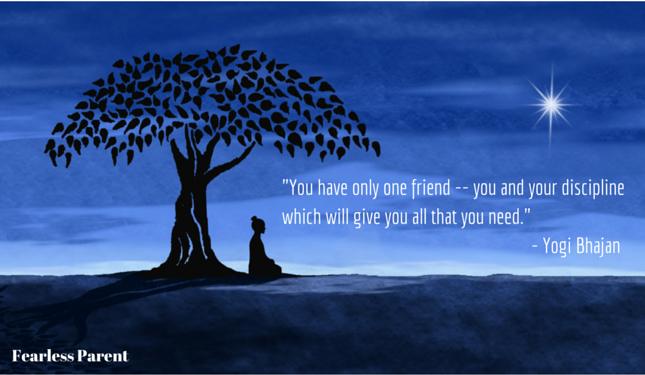
It doesn’t seem to make sense, how monumentally challenging this is. Logically, what’s 3 minutes? You can do almost anything for 180 seconds, right? But if you’re like me, be prepared for some massive resistance. You might find that you prefer scrubbing bathroom grout with a toothbrush or filing last year’s tax return over sitting quietly with yourself for 3 seconds. That’s a sign that this is going to be big for you, so just push through and do it. Behavioral scientists say that it takes a few weeks to break a new habit and 66 days to form a new one. I’m betting you’ll notice the benefits long before and touching that oasis of calm will motivate you to continue.
As for me, I still struggle. The toughest for me are those days that I don’t ground myself in meditation and prayer. I know what works and I fight it. I’m a recovering control freak and these behaviors die hard. No matter what’s happening, if I can drag myself to my mat, I always feel better when I release the burden from my narrow shoulders, surrender to God’s path, and breathe through.
 Louise Kuo Habakus is Executive Director of Fearless Parent and host and producer of Fearless Parent Radio.
Louise Kuo Habakus is Executive Director of Fearless Parent and host and producer of Fearless Parent Radio.

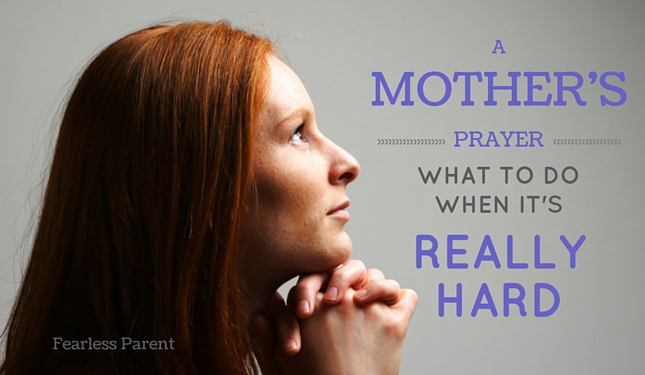


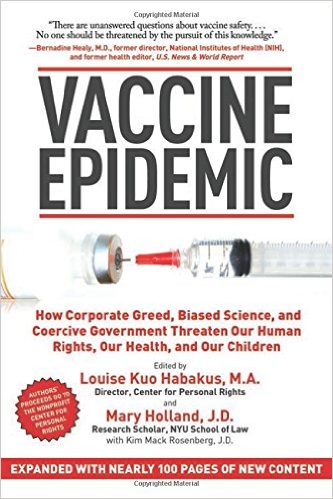


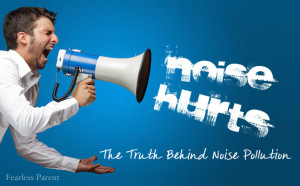
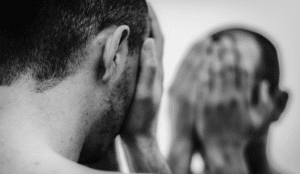
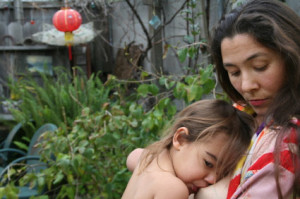


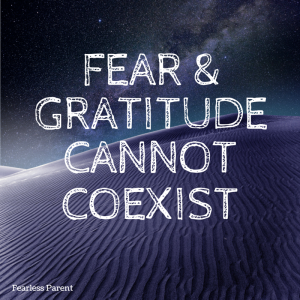
This is so excellent and heart gripping too. More than relatable here. Awesomely written!.(( heart emoticon ))
And even more heroic when they are ill themselves.
Beautiful, Louise. Thanks for writing it.
Yes and yes and yes and yes and YES!
What a gorgeous article Louise! You are truly inspirational.
<3 Thank you so much, Peggy.
Absolutely beautiful, I will be partaking in all of these gifts.
Love you Lou ! heart emoticon
Excellent article Louise…